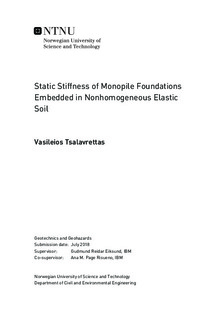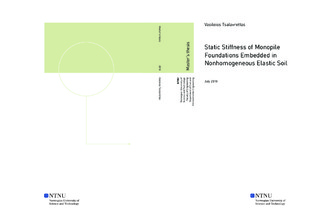| dc.description.abstract | Monopiles are the main foundation type for offshore wind turbines. The number of wind farms around the world is increasing rapidly which leads to more demanding design methods. Until now the use of p-y curves was the main design method for pile foundations. These curves were established for long slender (flexible) piles with small diameter and length to diameter ratio (L⁄D) > 35, for the oil industry. Several studies for rigid piles are have also took place the last years. This leads to a need for studying the gap between these two different dimension situations (flexible and rigid), which is the major dimension for the monopiles.
For designing a methodology for calculating the deflection at the mudline the NGI s in-house program PILES was used. Therefore, a simulation with 3 different stiffness coefficients was held. These coefficients will be the KF (lateral stiffness), KM (rotational stiffness) and KC (Coupling stiffness).
Firstly, a validation of the PILES results was essential to be conducted. So, a case study where the soil was considered as linear elastic with full saturated conditions, and the stiffness profile varies from constant elastic stiffness to linear and parabolic increase by depth. For the validation purpose the FEM program PLAXIS 3D was used. Also, well-established formulas from Gazetas and Shadlou represented the upper and lower boundaries of the study, for the flexible and rigid conditions respectively.
After proving the accuracy of the PILES program, a sensitive study took place. The results of this study were used to establish charts for calculating the stiffness coefficients. The results from the charts were compared to the program PILES and their accuracy is higher than 90%. Finally, an example of how to use the charts for calculating the stiffness coefficients were provided, as well as the deflections of the pile at the mudline level. | |

